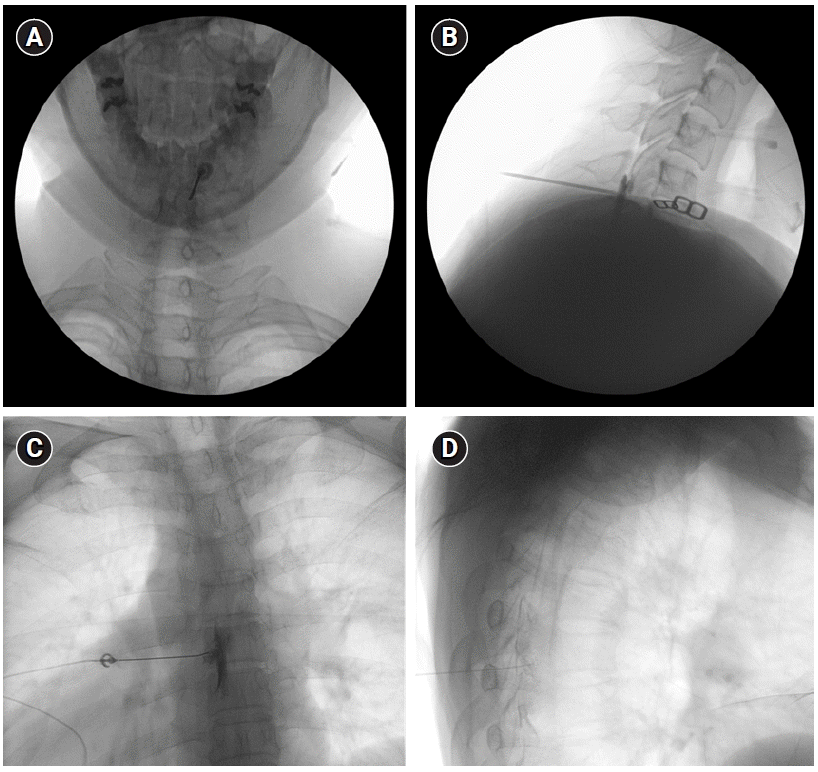1. Ljubisavljevic S. Postdural puncture headache as a complication of lumbar puncture: clinical manifestations, pathophysiology, and treatment. Neurol Sci. 2020; 41:3563–8.
2. Fichtner J, Fung C, Z'Graggen W, Raabe A, Beck J. Lack of increase in intracranial pressure after epidural blood patch in spinal cerebrospinal fluid leak. Neurocrit Care. 2012; 16:444–9.
3. Gormley JB. Treatment of postspinal headache. Anesthesiology. 1960; 21:565–6.
4. Russell R, Laxton C, Lucas DN, Niewiarowski J, Scrutton M, Stocks G. Treatment of obstetric post-dural puncture headache. Part 2: epidural blood patch. Int J Obstet Anesth. 2019; 38:104–18.
5. Buddeberg BS, Bandschapp O, Girard T. Post-dural puncture headache. Minerva Anestesiol. 2019; 85:543–53.
6. Crawford JS. Experiences with epidural blood patch. Anaesthesia. 1980; 35:513–5.
7. Kwak KH. Postdural puncture headache. Korean J Anesthesiol. 2017; 70:136–43.
8. Patel R, Urits I, Orhurhu V, Orhurhu MS, Peck J, Ohuabunwa E, et al. A comprehensive update on the treatment and management of postdural puncture headache. Curr Pain Headache Rep. 2020; 24:24.
9. Turnbull DK, Shepherd DB. Post-dural puncture headache: pathogenesis, prevention and treatment. Br J Anaesth. 2003; 91:718–29.
10. Mokri B. Spontaneous intracranial hypotension. Continuum (Minneap Minn). 2015; 21:1086–108.
11. Ferrante E, Trimboli M, Rubino F. Spontaneous intracranial hypotension: review and expert opinion. Acta Neurol Belg. 2020; 120:9–18.
12. Grant R, Condon B, Hart I, Teasdale GM. Changes in intracranial CSF volume after lumbar puncture and their relationship to post-LP headache. J Neurol Neurosurg Psychiatry. 1991; 54:440–2.
13. Bolden N, Gebre E. Accidental dural puncture management: 10-year experience at an academic tertiary care center. Reg Anesth Pain Med. 2016; 41:169–74.
14. Tubben RE, Jain S, Murphy PB. Epidural blood patch. In: StatPearls. Edited by Abai B, Abu-Ghosh A, Acharya AB, Acharya U, Adhia SG, Aeby TC, et al.: Treasure Island (FL), StatPearls Publishing;2021.
15. Katz D, Beilin Y. Review of the alternatives to epidural blood patch for treatment of postdural puncture headache in the parturient. Anesth Analg. 2017; 124:1219–28.
16. Russell R, Laxton C, Lucas DN, Niewiarowski J, Scrutton M, Stocks G. Treatment of obstetric post-dural puncture headache. Part 1: conservative and pharmacological management. Int J Obstet Anesth. 2019; 38:93–103.
17. Scemama P, Farah F, Mann G, Margulis R, Gritsenko K, Shaparin N. Considerations for epidural blood patch and other postdural puncture headache treatments in patients with COVID-19. Pain Physician. 2020; 23:S305–10.
18. Gaiser RR. Postdural puncture headache: an evidence-based approach. Anesthesiol Clin. 2017; 35:157–67.
19. Arevalo-Rodriguez I, Muñoz L, Godoy-Casasbuenas N, Ciapponi A, Arevalo JJ, Boogaard S, et al. Needle gauge and tip designs for preventing post-dural puncture headache (PDPH). Cochrane Database Syst Rev. 2017; 4:CD010807.
20. Kumar V, Maves T, Barcellos W. Epidural blood patch for treatment of subarachnoid fistula in children. Anaesthesia. 1991; 46:117–8.
21. Chauhan C, Francis GA, Kemeny AA. The avoidance of surgery in the treatment of subarachnoid cutaneous fistula by the use of an epidural blood patch: technical case report. Neurosurgery. 1995; 36:612–3; discussion 613-4.
22. Katz J. Treatment of a subarachnoid-cutaneous fistula with an epidural blood patch. Anesthesiology. 1984; 60:603–4.
23. Signorelli F, Caccavella VM, Giordano M, Ioannoni E, Caricato A, Polli FM, et al. A systematic review and meta-analysis of factors affecting the outcome of the epidural blood patching in spontaneous intracranial hypotension. Neurosurg Rev. 2021; 44:3079–85.
24. Kranz PG, Gray L, Malinzak MD, Amrhein TJ. Spontaneous intracranial hypotension: pathogenesis, diagnosis, and treatment. Neuroimaging Clin N Am. 2019; 29:581–94.
25. Amrhein TJ, Kranz PG. Spontaneous intracranial hypotension: imaging in diagnosis and treatment. Radiol Clin North Am. 2019; 57:439–451.
26. D'Antona L, Jaime Merchan MA, Vassiliou A, Watkins LD, Davagnanam I, Toma AK, et al. Clinical presentation, investigation findings, and treatment outcomes of spontaneous intracranial hypotension syndrome: a systematic review and meta-analysis. JAMA Neurol. 2021; 78:329–37.
27. Kranz PG, Malinzak MD, Amrhein TJ, Gray L. Update on the diagnosis and treatment of spontaneous intracranial hypotension. Curr Pain Headache Rep. 2017; 21:37.
28. Upadhyaya P, Ailani J. A review of spontaneous intracranial hypotension. Curr Neurol Neurosci Rep. 2019; 19:22.
29. Davidson B, Nassiri F, Mansouri A, Badhiwala JH, Witiw CD, Shamji MF, et al. Spontaneous intracranial hypotension: a review and introduction of an algorithm for management. World Neurosurg. 2017; 101:343–9.
30. Rettenmaier LA, Park BJ, Holland MT, Hamade YJ, Garg S, Rastogi R, et al. Value of targeted epidural blood patch and management of subdural hematoma in spontaneous intracranial hypotension: case report and review of the literature. World Neurosurg. 2017; 97:27–38.
31. So Y, Park JM, Lee PM, Kim CL, Lee C, Kim JH. Epidural blood patch for the treatment of spontaneous and iatrogenic orthostatic headache. Pain Physician. 2016; 19:E1115–22.
32. McInerney HJ, Lee M, Saunders T, Schabel J, Adsumelli RSN. Symptomatic intrathecal hematoma following an epidural blood patch for an obstetric patient with postdural puncture headache: a case report and synthesis of the literature. Case Rep Anesthesiol. 2020; 2020:8925731.
33. Seemiller J, Challagundla S, Taylor T, Zand R. Intrathecal blood injection: a case report of a rare complication of an epidural blood patch. BMC Neurol. 2020; 20:187.
34. Lee YG, Sa M, Oh I, Lim JA, Woo NS, Kim J. Multiple epidural fibrin glue patches in a patient with spontaneous intracranial hypotension - a case report -. Anesth Pain Med. 2019; 14:335–40.
35. Turner M. Epidural blood patch with allogeneic blood for post-dural puncture headache. Int J Obstet Anesth. 2006; 15:261; author reply 261-2.
36. McKenzie A, Manson L. Allogeneic blood for epidural blood patch–not without risk. Int J Obstet Anesth. 2006; 15:260; author reply 61-2.




 PDF
PDF Citation
Citation Print
Print




 XML Download
XML Download